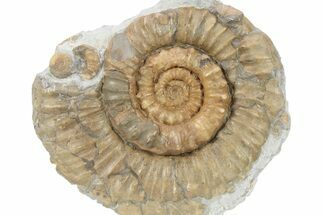This Specimen has been sold.
5.8" Fossil Ammonite (Arnioceras) Cluster - Klive, England
This is a 5.8" wide cluster of fossil ammonites (Arnioceras bodelii). It was collected from the Lower Jurassic deposits near Klive, England. There are two complete ammonites present, with an additional partial ammonite and two negative/partial ammonites that have been nicely prepared from the hard limestone. The specimen stands up nicely on a flat cut edge.
About Ammonites
Ammonites were ancient marine cephalopods, similar to today's squids and octopuses, but with a defining feature: their distinctive, tightly coiled spiral shells. These shells, resembling those of modern nautiluses, served as both a protective home and a buoyancy aid, allowing ammonites to navigate the prehistoric seas with ease. First emerging around 240 million years ago in the Triassic Period, ammonites thrived for over 175 million years, adapting through numerous forms and sizes. As predatory creatures, they likely fed on smaller marine organisms, using their tentacles to capture prey. However, their long reign came to an end 65 million years ago at the close of the Cretaceous, coinciding with the mass extinction event that also eliminated the dinosaurs.
Ammonites were ancient marine cephalopods, similar to today's squids and octopuses, but with a defining feature: their distinctive, tightly coiled spiral shells. These shells, resembling those of modern nautiluses, served as both a protective home and a buoyancy aid, allowing ammonites to navigate the prehistoric seas with ease. First emerging around 240 million years ago in the Triassic Period, ammonites thrived for over 175 million years, adapting through numerous forms and sizes. As predatory creatures, they likely fed on smaller marine organisms, using their tentacles to capture prey. However, their long reign came to an end 65 million years ago at the close of the Cretaceous, coinciding with the mass extinction event that also eliminated the dinosaurs.
SPECIES
Arnioceras bodelii
LOCATION
Klive, Somerset, England
SIZE
Cluster: 5.8 x 5.7", Largest ammonite: 3.1" wide
CATEGORY
SUB CATEGORY
ITEM
#243500
We guarantee the authenticity of all of our specimens.
 Reviews
Reviews












